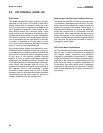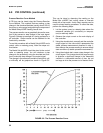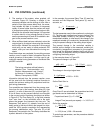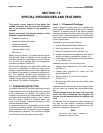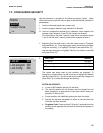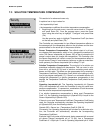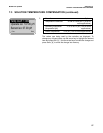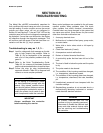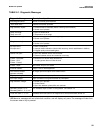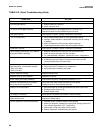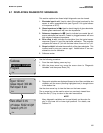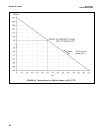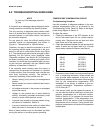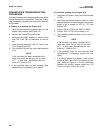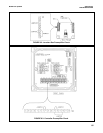
58
MODEL 54e pH/ORP SECTION 8.0
TROUBLESHOOTING
SECTION 8.0
TROUBLESHOOTING
The Model 54e pH/ORP automatically searches for
fault conditions that would cause an error in the meas-
ured pH reading. If such a condition occurs, the current
outputs and alarm relays will act as configured in
Section 5.6 and Section 5.7, the red "FAIL" LED on the
controller panel will be lit and a diagnostic message will
be displayed. If more than one fault exists, the display
will sequence through the diagnostic messages. This
will continue until the cause of the fault has been cor-
rected or until the Ack 2 key is pressed.
Troubleshooting is easy as 1, 2, 3…
Step 1 Look for a diagnostic fault message on the dis-
play to help pinpoint the problem. Refer to
Table 8-1 for an explanation of the message
and a list of the possible problems that trig-
gered it.
Step 2 Refer to the Quick Troubleshooting Guide,
Table 8-2, for common pH hardware problems
and the recommended actions to resolve them.
Step 3 Follow the step by step troubleshooting
approach offered in Table 8-3 to diagnose less
common or more complex problems.
CAUTION
Do not attempt to troubleshoot unless
you have familiarized yourself with this
manual. Only trained, qualified techni-
cians should perform these procedures.
Do not attempt to troubleshoot, repair, or
modify the printed circuit cards or elec-
tronic components inside the controller.
IMPORTANT
Always recalibrate the controller
before returning it to service.
Many control problems are unrelated to the pH meas-
urement system. When problems arise, first check
other systems that affect chemical concentration.
Consider what may have changed in the system that
can cause poor control. Some causes for poor control
other than controller malfunction are:
1. An empty chemical drum.
2. Malfunction of a chemical feed pump, pump motor,
or motor starter.
3. Water inlet or drain valves stuck or left open by
operators.
4. Check flow interlocks (if used).
5. A temperature control malfunction.
6. Broken or blocked chemical feed lines.
7. A conductivity probe that has been left out of the
bath.
8. The level of bath is below the probe and the probe
is dry.
9. The probe needs to be cleaned.
10. The condition of the incoming metal has changed,
i.e., temperature, cleanliness, speed.
11. The condition of the incoming water has changed,
i.e., temperature, cleanliness, flow rate, hardness,
pH.
12. Unauthorized personnel have tampered with the
controller settings.
13. Standardizing procedure is not accurate due to a
malfunctioning laboratory instrument or contami-
nated chemical standard solutions.
WARNING
To prevent chemical feed into the
process or injury to operating personnel,
disconnect or disable the chemical feed
pump and other external devices while
you are servicing and troubleshooting
the controller.



